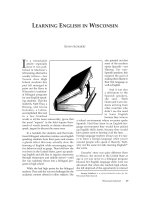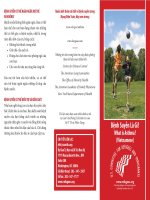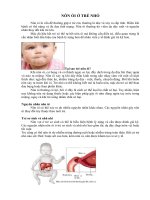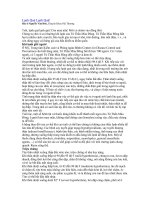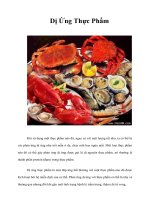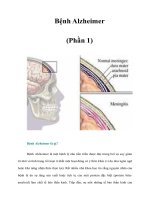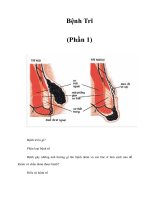Tài liệu Aging Research in Yeast doc
Bạn đang xem bản rút gọn của tài liệu. Xem và tải ngay bản đầy đủ của tài liệu tại đây (10.74 MB, 378 trang )
Aging Research in Yeast
SUBCELLULAR BIOCHEMISTRY
SERIES EDITOR
J. ROBIN HARRIS, University of Mainz, Mainz, Germany
ASSISTANT EDITORS
B.B. BISWAS, University of Calcutta, Calcutta, India
P. QUINN, King’s College London, London, UK
Recent Volumes in this Series
Volume 41 Chromatic and Disease
Edited by Tapas K. Kundu and Dipak Dasgupta
Volume 42 Inflammation in the Pathogenesis of Chronic Disease
Edited by Randall E. Harris
Volume 43 Subcellular Proteomics
Edited by Eric Bertrand and Michel Faupel
Volume 44 Peroxiredoxin Systems
Edited by Leopold Folhé and J. Robin Harris
Volume 45 Calcium Signalling and Disease
Edited by Ernesto Carafoli and Marisa Brini
Volume 46 Creatine and Creatine Kinase in Health and Disease
Edited by Gajja S. Salomons and Markus Wyss
Volume 47 Molecular Mechanisms of Parasite Invasion
Edited by Barbara A. Burleigh and Dominique Soldati-Favre
Volume 48 The Cronin Family of Proteins
Edited by Christoph S. Clemen and Ludwig Eichinger
Volume 49 Lipids in Health and Disease
Edited by Peter J. Quinn and Xiaoyuan Wang
Volume 50 Genome Stability and Human Diseases
Edited by Heinz-Peter Nasheuer
Volume 51 Cholesterol Binding and Cholesterol Transport Proteins
Edited by Robin J. Harris
Volume 52 A Handbook of Transcription Factors
Edited by Tim Hughes
Volume 53 Endotoxins: Stricture, Function and Recognition
Edited by Xiaoyuan Wang and Peter J. Quinn
Volume 54 Conjugation and Deconjugation of Ubiquitin Family Modifiers
Edited by Marcus Groettrup
Volume 55 Purinergic Regulation of Respiratory Diseases
Edited by Maryse Picher and Richard C. Boucher
Volume 56 Water Soluble Vitamins
Edited by Olaf Stanger
Michael Breitenbach · S. Michal Jazwinski ·
Peter Laun
Editors
Aging Research in Yeast
123
Editors
Prof. Dr. Michael Breitenbach
Department of Cell Biology
University of Salzburg
Hellbrunnerstrasse 34
5020 Salzburg
Austria
Prof. S. Michal Jazwinski
Department of Medicine
Tulane University Health Sciences Center
Tulane Center for Aging
Tulane University
1430 Tulane Avenue SL-12
New Orleans, Louisiana 70112
USA
Dr. Peter Laun
Department of Cell Biology
University of Salzburg
Hellbrunnerstrasse 34
5020 Salzburg
Austria
ISSN 0306-0225
ISBN 978-94-007-2560-7 e-ISBN 978-94-007-2561-4
DOI 10.1007/978-94-007-2561-4
Springer Dordrecht Heidelberg London New York
Library of Congress Control Number: 2011940010
© Springer Science+Business Media B.V. 2012
No part of this work may be reproduced, stored in a retrieval system, or transmitted in any form or by
any means, electronic, mechanical, photocopying, microfilming, recording or otherwise, without written
permission from the Publisher, with the exception of any material supplied specifically for the purpose
of being entered and executed on a computer system, for exclusive use by the purchaser of the work.
Printed on acid-free paper
Springer is part of Springer Science+Business Media (www.springer.com)
INTERNATIONAL ADVISORY EDITORIAL BOARD
R. Bittman, Queens College, City University of New York, New York, USA
D. Dasgupt, Saha Institute of Nuclear Physics, Calcutta, India
A. Holzenburg, Texas A&M University, Texas, USA
S. Rottem, The Hebrew University, Jerusalem, Israel
M. Wyss, DSM Nutritional Products Ltd., Basel, Switzerland
Contents
1 Introduction 1
Michael Breitenbach, Peter Laun, and S. Michal Jazwinski
2 Oxidative Stresses and Ageing 13
May T. Aung-Htut, Anita Ayer, Michael Breitenbach,
and Ian W. Dawes
3 The Role of Mitochondria in the Aging Processes of Yeast 55
Michael Breitenbach, Peter Laun, J. Richard Dickinson,
Andrea Klocker, Mark Rinnerthaler, Ian W. Dawes,
May T. Aung-Htut, Lore Breitenbach-Koller,
Antonio Caballero, Thomas Nyström, Sabrina Büttner,
Tobias Eisenberg, Frank Madeo, and Markus Ralser
4 The Retrograde Response and Other Pathways
of Interorganelle Communication in Yeast Replicative Aging 79
S. Michal Jazwinski
5 Chronological Aging in Saccharomyces cerevisiae 101
Valter D. Longo and Paola Fabrizio
6 Aging and the Survival of Quiescent and Non-quiescent
Cells in Yeast Stationary-Phase Cultures 123
M. Werner-Washburne, Sushmita Roy, and George S. Davidson
7 Maximising the Yeast Chronological Lifespan 145
Peter W. Piper
8 Amino Acid Homeostasis and Chronological Longevity
in Saccharomyces cerevisiae 161
John P. Aris, Laura K. Fishwick, Michelle L. Marraffini,
Arnold Y. Seo, Christiaan Leeuwenburgh, and William A. Dunn Jr.
9 DNA Damage and DNA Replication Stress in Yeast Models
of Aging 187
William C. Burhans and Martin Weinberger
vii
viii Contents
10 Yeast Aging and Apoptosis 207
Peter Laun, Sabrina Büttner, Mark Rinnerthaler,
William C. Burhans, and Michael Breitenbach
11 Cellular Homeostasis in Fungi: Impact on the Aging Process 233
Christian Q. Scheckhuber, Andrea Hamann, Diana Brust,
and Heinz D. Osiewacz
12 Genome-Wide Analysis of Yeast Aging 251
George L. Sutphin, Brady A. Olsen, Brian K. Kennedy,
and Matt Kaeberlein
13 Genetic Approaches to Aging in Budding and Fission
Yeasts: New Connections and New Opportunities 291
Bo-Ruei Chen and Kurt W. Runge
14 Evolution of Asymmetric Damage Segregation:
A Modelling Approach 315
Armin Rashidi, Thomas B.L. Kirkwood, and Daryl P. Shanley
15 Cellular Ageing and the Actin Cytoskeleton 331
David Amberg, Jane E. Leadsham, Vasillios Kotiadis,
and Campbell W. Gourlay
Index 353
Contributors
David Amberg Department of Biochemistry and Molecular Biology, SUNY
Upstate Medical University, Syracuse, NY, USA,
John P. Aris Department of Anatomy and Cell Biology, University of Florida,
Gainesville, FL 32610-0235, USA, johnaris@ufl.edu
May T. Aung-Htut School of Biotechnology and Biomolecular Sciences,
University of New South Wales, Sydney, NSW 2052, Australia,
Anita Ayer School of Biotechnology and Biomolecular Sciences, University of
New South Wales, Sydney, NSW 2052, Australia,
Michael Breitenbach Division of Genetics, Department of Cell Biology,
University of Salzburg, Salzburg, Austria,
Lore Breitenbach-Koller Division of Genetics, Department of Cell Biology,
University of Salzburg, Salzburg, Austria,
Diana Brust Faculty of Biosciences, Institute of Molecular Biosciences and
Cluster of Excellence Macromolecular Complexes, Johann Wolfgang Goethe
University, 60438 Frankfurt/Main, Germany,
William C. Burhans Department of Molecular and Cellular Biology, Roswell
Park Cancer Institute, Buffalo, NY 14222, USA,
Sabrina Büttner Institute of Molecular Biosciences, University of Graz, Graz,
Austria,
Antonio Caballero MRC Centre for Developmental Neurobiology, Guy’s
Campus, King’s College London, London, UK,
Bo-Ruei Chen Department of Genetics, Case Western Reserve University School
of Medicine, Cleveland, OH 44106, USA,
ix
x Contributors
George S. Davidson Department of Biology, University of New Mexico,
Albuquerque, NM 87131, USA,
Ian W. Dawes School of Biotechnology and Biomolecular Sciences, University of
New South Wales, Sydney, NSW 2052, Australia,
J. Richard Dickinson Department of Biochemistry, Cambridge Systems Biology
Centre, University of Cambridge, Cambridge, UK,
William A. Dunn Jr. Department of Anatomy and Cell Biology, University of
Florida, Gainesville, FL 32610-0235, USA, dunn@ufl.edu
Tobias Eisenberg Institute of Molecular Biosciences, University of Graz, Graz,
Austria,
Paola Fabrizio Laboratory of Molecular and Cellular Biology, UMR5239 CNRS,
Ecole Normale Supérieure de Lyon, Lyon, France,
Laura K. Fishwick Department of Anatomy and Cell Biology, University of
Florida, Gainesville, FL 32610-0235, USA, lfi
Campbell W. Gourlay Kent Fungal Group, School of Biosciences, University of
Kent, Canterbury, Kent CT2 7NJ, UK,
Andrea Hamann Faculty of Biosciences, Institute of Molecular Biosciences and
Cluster of Excellence Macromolecular Complexes, Johann Wolfgang Goethe
University, 60438 Frankfurt/Main, Germany,
S. Michal Jazwinski Department of Medicine, Tulane University Health Sciences
Center, Tulane Center for Aging, Tulane University, New Orleans, LA 70112,
USA,
Matt Kaeberlein Department of Pathology, University of Washington, Seattle,
WA 98195-7470, USA,
Brian K. Kennedy Buck Institute, Novato, CA 94945, USA,
Thomas B.L. Kirkwood Institute for Ageing and Health, Campus for Ageing and
Vitality, Newcastle University, Newcastle Upon Tyne NE4 5PL, UK,
Andrea Klocker Division of Genetics, Department of Cell Biology, University of
Salzburg, Salzburg, Austria,
Vasillios Kotiadis Kent Fungal Group, School of Biosciences, University of Kent,
Canterbury, Kent CT2 7NJ, UK,
Peter Laun Division of Genetics, Department of Cell Biology, University of
Salzburg, Salzburg, Austria,
Contributors xi
Jane E. Leadsham Kent Fungal Group, School of Biosciences, University of
Kent, Canterbury, Kent, CT2 7NJ, UK,
Christiaan Leeuwenburgh Department of Aging and Geriatric Research,
University of Florida, Gainesville, FL 32611-2610, USA, cleeuwen@ufl.edu
Valter D. Longo Department of Biological Sciences, Andrus Gerontology Center,
University of Southern California, Los Angeles, CA 90089-0191, USA,
Frank Madeo Institute of Molecular Biosciences, University of Graz, Graz,
Austria,
Michelle L. Marraffini Department of Anatomy and Cell Biology, University of
Florida, Gainesville, FL 32610-0235, USA, mmarraffi
Thomas Nyström Department of Cell and Molecular Biology (CMB), University
of Gothenburg, Göteborg, Sweden,
Brady A. Olsen Department of Pathology, University of Washington, Seattle, WA
98195-7470, USA,
Heinz D. Osiewacz Faculty of Biosciences, Institute of Molecular Biosciences
and Cluster of Excellence Macromolecular Complexes, Johann Wolfgang Goethe
University, 60438 Frankfurt/Main, Germany,
Peter W. Piper Department of Molecular Biology and Biotechnology, The
University of Sheffield, Sheffield S10 2TN, UK, peter.piper@sheffield.ac.uk
Markus Ralser Max Planck Institute for Molecular Genetics, Berlin, Germany,
Armin Rashidi Institute for Ageing and Health, Campus for Ageing and Vitality,
Newcastle University, Newcastle Upon Tyne NE4 5PL, UK,
Mark Rinnerthaler Division of Genetics, Department of Cell Biology,
University of Salzburg, Salzburg, Austria,
Sushmita Roy Broad Institute, 7 Cambridge Center, Cambridge, MA 02142,
USA,
Kurt W. Runge Department of Molecular Genetics, Lerner Research Institute,
Cleveland Clinic Lerner College of Medicine, Cleveland, OH 44195, USA,
Christian Q. Scheckhuber Faculty of Biosciences, Institute of Molecular
Biosciences and Cluster of Excellence Macromolecular Complexes, Johann
Wolfgang Goethe University, 60438 Frankfurt/Main, Germany,
xii Contributors
Arnold Y. Seo Department of Anatomy and Cell Biology, University of Florida,
Gainesville, FL 32610-0235, USA,
Daryl P. Shanley Institute for Ageing and Health, Campus for Ageing and
Vitality, Newcastle University, Newcastle Upon Tyne NE4 5PL, UK,
George L. Sutphin Department of Pathology and the Molecular and Cellular
Biology Program, University of Washington, Seattle, WA 98195-7470, USA,
Martin Weinberger Department of Molecular and Cellular Biology, Roswell
Park Cancer Institute, Buffalo, NY 14222, USA,
M. Werner-Washburne Department of Biology, University of New Mexico,
Albuquerque, NM 87131, USA,
Chapter 1
Introduction
Michael Breitenbach, Peter Laun, and S. Michal Jazwinski
Abstract Aging in yeast is now a well researched area with hundreds of new
research and review papers appearing every year. The chapters following in this
book written by some of the leading experts in the field will give an overview of
the most relevant areas of yeast aging. The purpose of this chapter is to give the
newcomer an introduction to the field including some basic technical questions.
Keywords Saccharomyces cerevisiae · Replicative aging · Rejuvenation ·
Asymmetric segregation · Stem cells
General Introductory Remarks
Cells of the budding yeast, S. cerevisiae, have f or several decades now been con-
sidered as the prototypic eukaryotic cells, ideally suited to s tudy and uncover many
of the basic phenomena of eukaryotic life. This is because of the unrivaled ease
and speed of genetic and molecular genetic analysis in yeast, the small genome size
(12 Mbp), the short doubling time (80 min on complex media), a fully developed
system of sexual reproduction with stable haploid as well as diploid phases enabling
complementation as well as recombination analysis (Dickinson and Schweizer
2004; Stansfield and Stark 2007).
Methods of “reverse genetics” are efficient and easy to handle making yeast one
of only two model organisms of aging where exact gene replacement resulting in
“knock in” strains can be routinely performed. The other cell type where this can
routinely be achieved at present, although with a much higher investment of time and
money, is ES cells of the mouse. In this way, any desired mutation can be introduced
at will in haploid cells in the about 4800 non-essential yeast genes. In the remaining
about 1200 “essential” yeast genes, the same is true, but a severe loss of function
would lead to death, and these mutations have to be kept in a heterozygous state.
Knowing the yeast whole genome sequence and the functional annotation of
yeast genes which has taken place over the last 15 years, and using high throughput
M. Breitenbach (B)
Division of Genetics, Department of Cell Biology,
University of Salzburg, Salzburg, Austria
e-mail:
1
M. Breitenbach et al. (eds.), Aging Research in Yeast, Subcellular Biochemistry 57,
DOI 10.1007/978-94-007-2561-4_1,
C
Springer Science+Business Media B.V. 2012
2 M. Breitenbach et al.
methods and the many publicly available mutant and gene collections, i ncluding
cDNA microarrays, whole genome screening procedures have become a powerful
tool for yeast genetic research and have also been used for aging research.
However, of course, not every aspect of eukaryotic life can be modeled in yeast
and an obvious example is development and cell differentiation, which exists in
yeast, but is much more complex in higher multicellular organisms.
The questions which we are asking here are: are the cellular aging processes of
yeast which are described in this book, relevant and similar in mechanism to the
cellular aging processes observed in cultured higher cells and in higher organisms?
What can we learn from yeast aging that is relevant to understand the aging pro-
cesses of higher organisms? Can this lead to interventions in the aging process of
humans that improve the lifespan and health span of humans? In order to answer
these questions, we must understand the molecular genetic pathways relevant to
aging both in yeast and in higher organisms and we have to compare the two systems
with special emphasis on highly conserved genes playing a role in those path-
ways. Highly conserved genes, pathways, and external interventions would point
to “public mechanisms of aging”, while such genes and pathways that are found to
influence aging only in a restricted number of organisms, are called “private mecha-
nisms of aging” (Martin et al. 1996). One example for a public mechanism is caloric
restriction (Jiang et al. 2000; Kaeberlein et al. 2005) while an example for a private
mechanism of aging is provided by the extrachromosomal circles of ribosomal DNA
(ERCs) (Sinclair and Guarente 1997) in yeast mother cell-specific aging. The model
systems for organismic aging of higher organisms which are most highly developed
are the mouse (important because it is so closely related to humans), Drosophila
melanogaster, and Caenorhabditis elegans.
Yeast supplies us with two independent aging models which both have similar-
ities to cellular aging processes in humans but have little to do with each other in
terms of the genes which are involved (Laun et al. 2006). The main purpose of this
Introduction is to present these two aging processes, to compare them with each
other, and to evaluate them with regard to the aging processes in the human body
for which they are claimed to be models.
Mother Cell-Specific (Replicative) Aging of Yeast Cells
Individual yeast cells of standard laboratory strains can produce only a limited num-
ber, typically 20–30, daughter cells during a lifetime (Mortimer and Johnston 1959).
This process takes about 2–3 days on complex media at 28
◦
C and is therefore one
of the most r apid aging processes known. The lifespan of a cell is counted in gen-
erations (buds, daughter cells produced), but not in calendar time and is actually
independent of calendar time (Müller et al. 1980). During the process, the mother
cell becomes bigger with every generation and accumulates bud scars ( Fig. 1.1).
Mother cells change gradually in cycle duration (Egilmez and Jazwinski 1989) and
many other biochemical parameters like ROS content (Laun et al. 2001) and protein
carbonyl content (Aguilaniu et al. 2003), until they reach a final state of senescence
1 Introduction 3
Fig. 1.1 Scanning electron microscopy pictures obtained by standard procedures after elutriation
centrifugation (Laun et al. 2001) of a haploid strain (BY4741). a Fraction II young yeast cells.
Note small size, the smooth surface and the infrequent bud scars. Virgin cells display no bud scars
but only one birth scar. b Fraction V old mother cells of the same strain. Note the large size,
the irregular surface and the multiple bud scars. Both pictures shown at the same magnification
(unpublished data of the authors)
characterized by loss of cell cycle checkpoint mechanisms (Nestelbacher et al.
2000), loss of heterozygosity in diploid cells (McMurray and Gottschling 2004),
and apoptosis (Laun et al. 2001). On the other hand, the daughter cells which are
born to young and old mother cells, are rejuvenated: they differ in size only slightly
(Klinger et al. 2010) and reset their clock to zero preventing clonal aging of the
strain (Egilmez and Jazwinski 1989). A schematic representation of this process
is shown in the now familiar “spiral” picture (Fig. 1.2). Only the daughters of very
old mothers on glucose media inherit some of the “death factor” (damaged material)
(Egilmez and Jazwinski 1989) and display a somewhat shortened lifespan (Kennedy
et al. 1994). The mechanism by which rejuvenation is possible is of the highest
interest and relevance but is not well understood yet today.
Mother Cell-Specific Aging Is a Stochastic Phenomenon
A cohort of about 60 cells, which is about the minimum for a statistically signifi-
cant characterization of aging of a strain, displays a distribution of lifespans which
follows the Gompertz law (Jazwinski et al. 1989) (Fig. 1.3). The median of this dis-
tribution function is the best single parameter to describe the lifespan of the strain in
question. As shown in Fig. 1.3, single gene mutations are known which significantly
increase the replicative lifespan of yeast.
In the case of replicative life span, the decrease in survival probability is expo-
nential with increasing generations (cell divisions) completed (Gompertz 1825).
However, this relationship breaks down for the last survivors in an aging cohort
due to the plateau in mortality rate at late ages (Jazwinski et al. 1998).
4 M. Breitenbach et al.
Fig. 1.2 Schematic of
mother cell-specific aging
(Jazwinski et al. 1989). Every
cell division cycle is
represented by one turn of the
spiral. In every generation the
mother cell grows and ages,
while the daughter cell is
rejuvenated and increases in
size only slightly (Klinger
et al. 2010). The terminally
senescent mother cell can no
longer produce a bud and
eventually dies and lyses
through apoptosis (picture
taken from Jazwinski et al.
1989; with permission from
Elsevier)
The morphological asymmetry of mothers and daughters of budding yeast is very
obvious and it is now clear that many of the cellular components are asymmetrically
segregated in this process, among them damaged proteins and organelles (Aguilaniu
et al. 2003; Eldakak et al. 2010; Erjavec and Nystrom 2007; Klinger et al. 2010;
Lai et al. 2002). The damaged material is retained in the mother while the fully
functional cell components are transmitted to the daughter ensuring her rejuvena-
tion. It is important to note that a similar process of asymmetric segregation take
place even in cells where both progeny formed in a cell division cycle are mor-
phologically equal (E. coli, S. pombe; Barker and Walmsley 1999; Nystrom 2007),
and very probably in every living cell. Morphological and/or functional asymme-
try is the basis of a theory of aging (Erjavec et al. 2008; but also Rashidi et al.
(Chapter 14, this volume); Jazwinski 1993) that was explicitly tested in S. pombe
(Barker and Walmsley 1999) before asymmetry had been recognized in this organ-
ism. Arguably, the asymmetric distribution and hence the differential transport of
damaged cellular material (“waste”) is necessary to prevent clonal aging which
would eventually lead to death of all descendants of a cell, and therefore to the
death of the species. Why is asymmetric segregation so important? Actually it
is closely linked to the problem of selective degradation of damaged material in
1 Introduction 5
Fig. 1.3 Mother cell-specific lifespan distribution (replicative survival curve) of a wild type
strain (BY4741, triangles) and an congenic mutant deleted for afo1 (circles), a gene coding for
a mitochondrial ribosomal protein. The mutant is respiratory deficient and significantly long-lived
(Heeren et al. 2009). About 40–50 individual cells each were micromanipulated to obtain the sur-
vival curves shown to obtain adequate statistics (picture modified after Heeren et al. 2009, with
permission from Impact Journals LLC)
all cells. Numerous interlinked degradation pathways exist, but autophagy (only
in eukaryotes) and the eukaryotic proteasome and its prokaryotic equivalent, the
Lon protease, constitute the most important pathways. The overriding importance
of the cellular degradation pathways to prevent cellular aging have been stressed
by many authors (for example: Vellai 2009, and it is discussed at some length
in a Chapter 4 in this book [Jazwinski]; Vernace et al. 2007). These processes
are essential for life, but they do not work with 100% efficiency. We argue that
deposition of the remaining damaged material in the mother cell is necessary in
addition to functional autophagy and proteasomal degradation, to prevent clonal
aging.
Comparison with “Hayflick Type Aging” of Human Cells
Leonard Hayflick discovered (Hayflick and Moorhead 1961) that human cells in
culture (for instance, dermal fibroblasts or human umbilical vein endothelial cells,
HUVEC) have a limited lifespan and undergo clonal aging resulting in death of all
descendants of the primary cell. The aging HUVEC display remarkable similarity to
aging yeast mother cells, in particular both cell types increase in size, produce ROS,
collapse their actin cytoskeleton to large patches of F-actin, and undergo apoptosis
(Breitenbach et al. 2003). However, other cell types do not apoptose after ceasing
cell division but instead undergo a process called cellular senescence, remaining
viable in a non-dividing state over a prolonged period of time. The discovery and
6 M. Breitenbach et al.
subsequent analysis of Hayflick aging was greeted with much enthusiasm, because
the lifespan of a cell culture depends on the species and is proportional to the
lifespan of the species. The in vitro lifespan correlates with the age of the donor
individual, is characterized by telomere shortening, and can be elongated by several
cell generations by ectopically expressing telomerase in the cultured cells (Blasco
2007; Bodnar et al. 1998). However, it is unclear to what degree the Hayflick phe-
nomenon depends on the unphysiological oxygen partial pressure that was used in
nearly all cell culture experiments and to what degree Hayflick aging occurs in the
human body and actually limits lifespan. (There is, however, evidence that senes-
cent cells accumulate during aging in human tissues. Work by Judy Campisi (Freund
et al. 2010) suggests that these senescent cells have a pro-inflammatory and tissue
proteolytic phenotype. This has an effect on neighboring cells, called the bystander
effect). Measuring the Hayflick limit in low oxygen (3–5% similar to the oxygen
partial pressure prevalent at peripheral tissues instead of the usual 21%) leads to a
large increase in cell lifespan and perhaps immortality (Fehrer et al. 2007); a ques-
tion most pertinent in the case of stem cells. These are open questions at present
which are not the subject of our book.
Comparing Mother Cell-Specific Aging to the Aging of a Stem Cell
Population
Presently, the role in aging and the changes in stem cell number and quality dur-
ing the aging process of higher organisms are at the center of research interests.
In this connection, it was noted early on that the process of mother cell-specific
aging caused by asymmetric cell divisions is similar to the asymmetric divisions
observed in stem cell populations of the human body (Lai et al. 2002). Cell divi-
sions of stem cells are asymmetric and result in one rejuvenated new stem cell
(akin t o the yeast daughter cell) and one differentiated cell (progenitor cell) that
has performed the first step towards a mature cell and eventually after many more
cell divisions reaches a terminal state and no longer divides. The best studied among
stem cell populations are the populations of hematopoietic stem cells of the red bone
marrow and also muscle stem cells (satellite cells). There is at present much infor-
mation available about changes in gene expression comparing stem cells and their
differentiated derivatives, but nearly no information about asymmetric distribution
of damaged material in the same process. However, studies of stem cell aging are
now beginning and an increasing number of papers about the aging of stem cell pop-
ulations appears, starting around 2005 (examples: Conboy and Rando 2005; Rando
2006). These papers also show the limits of the analogy between yeast mother cell-
specific aging and stem cell aging: The yeast daughter cell rejuvenates completely;
if it could not do so, the species would have died out long ago. The typical stem
cell (muscle stem cell in the above example) needs a stem cell niche (which the
yeast cell does not have) and ages, i.e. changes its quality during a lifetime with far-
reaching consequences for the regeneration potential of the organ, stem cell therapy
and related medical problems. There is only one cell type in the human body which
1 Introduction 7
must by definition rejuvenate completely: this is the population of germ line stem
cells which give rise to gametes. How they do it is a complete mystery at present.
Chronological Aging of Stationary (Non-growing) Yeast Cells
This is the second aging model system which yeast offers us. It has been compared
to the aging of postmitotic cells of the human body, most prominently to the aging
of neurons in the central nervous system. Chronological aging, or the survival of sta-
tionary yeast cells is studied measuring clonogenicity of a stationary yeast culture,
which is kept with shaking and aeration at 28
◦
C in the spent medium for several
weeks (see the chapters of Fabrizio and Longo (Chapter 4), Werner-Washburne
et al. (Chapter 6) and of Piper (Chapter 7), this volume for a detailed description).
Aliquots are plated out every day on complex media and the number of colonies is
counted after 2 more days. Depending on the strain background and the media used,
an exponential decay of clonogenicity is observed and typical half lives found in lab-
oratory s trains are between one and three weeks. Single gene mutations are known
that lead to a large increase in chronological lifespan under otherwise identical con-
ditions (Fig. 1.4). When the aging of postmitotic human cells and of stationary yeast
cells are compared, some obvious similarities are observed, but also some obvious
differences. In yeast chronological lifespan assays, the cells observed are starving
and their survival depends to a large extent on the genetic response to starvation con-
ditions resulting in a large number of morphological and physiological changes (see
the Chapter 6 by Werner-Washburne et al. this volume). These changes were essen-
tial during evolution for survival of the species, because wild yeasts for the larger
part of their life (for instance during winter in moderate climates!) are actually in
non-growing (starving) conditions. It should be kept in mind, though, that yeast
cells in the wild are largely diploid and undergo sporulation on starvation, yielding
the long lived dispersal form called the spore. On the other hand, postmitotic human
cells in grown-up individuals (neurons of the brain, myotubes of the muscle, and the
Fig. 1.4 Chronological
survival of wild type
DBY746 (circles)and
congenic long-lived sch9
deletion mutant (squares)
(after Fabrizio and Longo
2003; with permission from
John Wiley and Sons)
8 M. Breitenbach et al.
like) are not starved, but on the contrary at their peak metabolic activity; consider
ATP production and respiration as an example. These cells therefore have to cope
with different problems, like for instance damage removal by autophagy and other
mechanisms. Dying s tationary yeast cells undergo apoptosis (Herker et al. 2004).
One of the most important findings in the field of chronological aging of yeast was
the discovery of two quite different cell populations in stationary cultures (Fig. 1.5)
(Allen et al. 2006), one of which, the replicatively young cells (daughters), are mor-
phologically differentiated, display low metabolic activity and are very long-lived,
while the other cells in stationary culture are prone to apoptosis, lyse, and can to
some degree feed the other part and lead to adaptive re-growth (Fabrizio and Longo
2008).
Fig. 1.5 Two distinct cell populations are formed in yeast cultures entering stationary phase. a
Density-gradient separation of two distinct cell fractions in S288c cultures as a function of time
after inoculation. Glucose exhaustion (arrow) occurred 12 h after inoculation. b Phase contrast,
transmission EM (TEM), and phosphotungstic acid-stained transmission EM micrographs of upper
and lower-fraction cells from stationary phase cultures (7 days after inoculation). The white arrow
indicates vacuolar vesicles, and the black arrow indicates accumulated glycogen. V, vacuole. Bars:
10 μm(left); 1 μm(middle and right) (picture taken from Allen et al. 2006; Originally published
in JCB. doi: 10.1083/jcb.200604072)
1 Introduction 9
Caloric Restriction and the Role of Intermediary Metabolism
Over the last few years it became increasingly clear that basic carbon metabolism
and intermediary metabolism plays a central role in the determination of lifespan. In
rodents (mice, rats, and others) it was shown that allowing about 70% of the ad libi-
tum food intake of a well-balanced diet containing all necessary components like
essential amino acids, vitamins, and trace elements, led to an increase in lifespan
and healthspan (as measured for instance by cardiovascular parameters) of about
50%. The incidence of cancer and cardio-vascular pathologies was much lower in
the calorically restricted animals, comparing them with their age-matched ad libi-
tum fed littermates. It is an open question, if such an intervention can slow down the
aging process in primates (Anderson et al. 2009; Ingram et al. 2007) and humans,
although promising reports on brain and heart aging in calorically restricted rhesus
monkeys have been published (Kastman et al. 2010; McKiernan et al. 2011). Most
recently, it has been reported that indeed CR may extend the lifespan of Rhesus
monkeys (Colman et al. 2009). It is of course interesting, if the same interven-
tion can positively influence the replicative as well as the chronological aging of
yeast. In most papers, low glucose (0.5% instead of the usual 2%) was shown to
enhance the RLS as well as the CLS of yeast. However, we would like to caution
the reader that this intervention is not the same as reducing the total intake of an oth-
erwise balanced diet. Lowering glucose is well known to relieve glucose repression
in yeast, which for instance stimulates mitochondrial respiration substantially, while
other essential components of the media remain the same. It is important to separate
this increase in mitochondrial respiration from possible other consequences of low
glucose by experiments with non-respiring strains, which has been done with con-
troversial results (Kaeberlein et al. 2005; Lin and Guarente 2006; Lin et al. 2002).
In one study, the influence of the whole range from 0.1 to 5% glucose on RLS was
tested, and it was shown that low glucose as well as very high glucose leads to
a substantial elongation of RLS (Kaeberlein et al. 2002). In another study, further
decreases in glucose levels past the point at which the cells are released from glu-
cose repression resulted in progressive increases in RLS (Jiang et al. 2000). Low
glucose can also increase CLS (Chapter 5, this volume), but no systematic testing
of the whole range of glucose concentrations is available, and most importantly,
nobody has tested a balanced reduced diet for yeast. Reducing the availability of
amino acids in the diet leads to an increase in lifespan (Houtkooper et al. 2010).
This was shown for RLS in yeast as well (Jiang et al. 2000), and unpublished studies
indicate that glutamate and aspartate play a central role (our own unpublished obser-
vations, SMJ). Recently this was shown for methionine in Drosophila (Grandison
et al. 2009) and for tryptophan in yeast RLS (our own unpublished observations,
MB). There are interesting gene-regulatory overlaps between caloric restriction and
the retrograde response in yeast that may be related to the role of TOR (Wang
et al. 2010 and they are discussed in a subsequent Chapter 4 by Jazwinski, this
volume.).
After this introductory discussion of the two aging models of yeast and the influ-
ence of caloric restriction on yeast aging, we may again ask the question as to the
10 M. Breitenbach et al.
real driving force of organismic aging in higher organisms and what it possibly has
to do with replicative and chronological aging of yeast.
The final word has not been said, but the aging processes seem to be multifacto-
rial and multicausal with only some of the mechanisms known at this time. Survival
of postmitotic cells on the one hand, and regenerative capacity provided by stem
cell populations, together determine the lifespan of an organ.
The yeast RLS and CLS, we argue, may serve as models that stress the role that
the handling of molecular damage by cells plays. Damage accumulation in cells
produces a variety of stresses and the genetic program of stress response is what we
observe as a “genetic program of aging”. It can be expected that the processes of
damage removal (autophagy and proteasomal degradation, and others), of apoptosis
and of regeneration of tissues by activating stem cells, will be in the center of aging
research in the future. The interaction of damage removal and asymmetric segrega-
tion of damage is a new and powerful paradigm in aging research. Yeast molecular
biology and genetics will supply a substantial contribution to the open questions of
future aging research.
References
Aguilaniu H, Gustafsson L, Rigoulet M, Nystrom T (2003) Asymmetric inheritance of oxidatively
damaged proteins during cytokinesis. Science 299:1751–1753
Allen C, Buttner S, Aragon AD, Thomas JA, Meirelles O, Jaetao JE, Benn D, Ruby SW,
Veenhuis M, Madeo F, Werner-Washburne M (2006) Isolation of quiescent and nonquiescent
cells from yeast stationary-phase cultures. J Cell Biol 174:89–100
Anderson RM, Shanmuganayagam D, Weindruch R (2009) Caloric restriction and aging: studies
in mice and monkeys. Toxicol Pathol 37:47–51
Barker MG, Walmsley RM (1999) Replicative ageing in the fission yeast Schizosaccharomyces
pombe. Yeast 15:1511–1518
Blasco MA (2007) Telomere length, stem cells and aging. Nat Chem Biol 3:640–649
Bodnar AG, Ouellette M, Frolkis M, Holt SE, Chiu C-P, Morin GB, Harley CB, Shay JW,
Lichtsteiner S, Wright WE (1998) Extension of life-span by introduction of telomerase into
normal human cells. Science 279:349–352
Breitenbach M, Madeo F, Laun P, Heeren G, Jarolim S, Fröhlich K-U, Wissing S, Pichova
A (2003) Yeast as a model for ageing and apoptosis research. Model systems in aging. Springer,
Berlin/Heidelberg, pp 61–97
Colman RJ, Anderson RM, Johnson SC, Kastman EK, Kosmatka KJ, Beasley TM, Allison DB,
Cruzen C, Simmons HA, Kemnitz JW, Weindruch R (2009) Caloric restriction delays disease
onset and mortality in rhesus monkeys. Science 325:201–204
Conboy IM, Rando TA (2005) Aging, stem cells and tissue regeneration: lessons from muscle. Cell
Cycle 4:407–410
Dickinson JR, Schweizer M (eds) (2004) The metabolism and molecular physiology of
Saccharomyces cerevisiae, 2nd edn. CRC Press, London
Egilmez NK, Jazwinski SM (1989) Evidence for the involvement of a cytoplasmic factor in the
aging of the yeast Saccharomyces cerevisiae. J Bacteriol 171:37–42
Eldakak A, Rancati G, Rubinstein B, Paul P, Conaway V, Li R (2010) Asymmetrically inherited
multidrug resistance transporters are recessive determinants in cellular replicative ageing. Nat
Cell Biol 12:799–805
1 Introduction 11
Erjavec N, Cvijovic M, Klipp E, Nystrom T (2008) Selective benefits of damage partitioning in
unicellular systems and its effects on aging. Proc Natl Acad Sci USA 105:18764–18769
Erjavec N, Nystrom T (2007) Sir2p-dependent protein segregation gives rise to a superior reactive
oxygen species management in the progeny of Saccharomyces cerevisiae. Proc Natl Acad Sci
USA 104:10877–10881
Fabrizio P, Longo VD (2003) The chronological life span of Saccharomyces cerevisiae. Aging Cell
2:73–81
Fabrizio P, Longo VD (2008) Chronological aging-induced apoptosis in yeast. Biochim Biophys
Acta 1783:1280–1285
Fehrer C, Brunauer R, Laschober G, Unterluggauer H, Reitinger S, Kloss F, Gully C, Gassner R,
Lepperdinger G (2007) Reduced oxygen tension attenuates differentiation capacity of human
mesenchymal stem cells and prolongs their lifespan. Aging Cell 6:745–757
Freund A, Orjalo AV, Desprez PY, Campisi J (2010) Inflammatory networks during cellular
senescence: causes and consequences. Trends Mol Med 16:238–246
Gompertz B (1825) On the nature of the function expressive of the law of human mortality,
and on a new mode of determining the value of life contingencies. Philos Trans R Soc Lond
115:513–585
Grandison RC, Piper MD, Partridge L (2009) Amino-acid imbalance explains extension of lifespan
by dietary restriction in Drosophila. Nature 462:1061–1064
Hayflick L, Moorhead PS (1961) The serial cultivation of human diploid cell strains. Exp Cell Res
25:585–621
Heeren G, Rinnerthaler M, Laun P, von Seyerl P, Kossler S, Klinger H, Hager M, Bogengruber E,
Jarolim S, Simon-Nobbe B, Schuller C, Carmona-Gutierrez D, Breitenbach-Koller L, Muck C,
Jansen-Durr P, Criollo A, Kroemer G, Madeo F, Breitenbach M (2009) The mitochondrial ribo-
somal protein of the large subunit, Afo1p, determines cellular longevity through mitochondrial
back-signaling via TOR1. Aging (Albany NY) 1:622–636
Herker E, Jungwirth H, Lehmann KA, Maldener C, Frohlich KU, Wissing S, Buttner S, Fehr M,
Sigrist S, Madeo F (2004) Chronological aging leads to apoptosis in yeast. J Cell Biol 164:501–
507
Houtkooper RH, Williams RW, Auwerx J (2010) Metabolic networks of longevity. Cell 142:9–14
Ingram DK, Young J, Mattison JA (2007) Calorie restriction in nonhuman primates: assessing
effects on brain and behavioral aging. Neuroscience 145:1359–1364
Jazwinski SM (1993) The genetics of aging in the yeast Saccharomyces cerevisiae. Genetica
91:35–51
Jazwinski SM (1998) Genetics of longevity. Exp Gerontol 33:773–783
Jazwinski SM, Egilmez NK, Chen JB (1989) Replication control and cellular life span. Exp
Gerontol 24:423–436
Jazwinski SM, Kim S, Lai CY, Benguria A (1998) Epigenetic stratification: the role of individual
change in the biological aging process. Exp Gerontol 33:571–580
Jiang JC, Jaruga E, Repnevskaya MV, Jazwinski SM (2000) An intervention resembling caloric
restriction prolongs life span and retards aging in yeast. FASEB J 14:2135–2137
Kaeberlein M, Andalis AA, Fink GR, Guarente L (2002) High osmolarity extends life span
in Saccharomyces cerevisiae by a mechanism related to calorie restriction. Mol Cell Biol
22:8056–8066
Kaeberlein M, Hu D, Kerr EO, Tsuchiya M, Westman EA, Dang N, Fields S, Kennedy BK (2005)
Increased life span due to calorie restriction in respiratory-deficient yeast. PLoS Genet 1:e69
Kastman EK, Willette AA, Coe CL, Bendlin BB, Kosmatka KJ, McLaren DG, Xu G, Canu E,
Field AS, Alexander AL, Voytko ML, Beasley TM, Colman RJ, Weindruch RH, Johnson
SC (2010) A calorie-restricted diet decreases brain iron accumulation and preserves motor
performance in old rhesus monkeys. J Neurosci 30:7940–7947
Kennedy BK, Austriaco NR, Guarente L (1994) Daughter cells of Saccharomyces cerevisiae from
old mothers display a reduced life span. J Cell Biol 127:1985–1993
12 M. Breitenbach et al.
Klinger H, Rinnerthaler M, Lam YT, Laun P, Heeren G, Klocker A, Simon-Nobbe B, Dickinson JR,
Dawes IW, Breitenbach M (2010) Quantitation of (a)symmetric inheritance of functional and
of oxidatively damaged mitochondrial aconitase in the cell division of old yeast mother cells.
Exp Gerontol 45:533–542
Lai CY, Jaruga E, Borghouts C, Jazwinski SM (2002) A mutation in the ATP2 gene abrogates
the age asymmetry between mother and daughter cells of the yeast Saccharomyces cerevisiae.
Genetics 162:73–87
Laun P, Pichova A, Madeo F, Fuchs J, Ellinger A, Kohlwein S, Dawes I, Frohlich KU,
Breitenbach M (2001) Aged mother cells of Saccharomyces cerevisiae show markers of
oxidative stress and apoptosis. Mol Microbiol 39:1166–1173
Laun P, Rinnerthaler M, Bogengruber E, Heeren G, Breitenbach M (2006) Yeast as a model for
chronological and reproductive aging – a comparison. Exp Gerontol 41:1208–1212
Lin SJ, Guarente L (2006) Increased life span due to calorie restriction in respiratory-deficient
yeast. PLoS Genet 2:e33; author reply e34
Lin SJ, Kaeberlein M, Andalis AA, Sturtz LA, Defossez PA, Culotta VC, Fink GR, Guarente L
(2002) Calorie restriction extends Saccharomyces cerevisiae lifespan by increasing respiration.
Nature 418:344–348
Martin GM, Austad SN, Johnson TE (1996) Genetic analysis of ageing: role of oxidative damage
and environmental stresses. Nat Genet 13:25–34
McKiernan SH, Colman RJ, Lopez M, Beasley TM, Aiken JM, Anderson RM, Weindruch R (2011
Jan) Caloric restriction delays aging-induced cellular phenotypes in rhesus monkey skeletal
muscle. Exp Gerontol 46(1):23–29
McMurray MA, Gottschling DE (2004) Aging and genetic instability in yeast. Curr Opin Microbiol
7:673–679
Mortimer RK, Johnston JR (1959) Life span of individual yeast cells. Nature 183:1751–1752
Müller I, Zimmermann M, Becker D, Flömer M (1980) Calendar life span versus budding lifespan
of Saccharomyces cerevisiae. Mech Ageing Dev 12:47–52
Nestelbacher R, Laun P, Vondrakova D, Pichova A, Schuller C, Breitenbach M (2000) The
influence of oxygen toxicity on yeast mother cell-specific aging. Exp Gerontol 35:63–70
Nystrom T (2007) A bacterial kind of aging. PLoS Genet 3:e224
Rando TA (2006) Stem cells, ageing and the quest for immortality. Nature 441:1080–1086
Sinclair DA, Guarente L (1997) Extrachromosomal rDNA circles – a cause of aging in yeast. Cell
91:1033–1042
Stansfield I, Stark M (eds) (2007) Yeast gene analysis. Academic Press, London
Vellai T (2009) Autophagy genes and ageing. Cell Death Differ 16:94–102
Vernace VA, Schmidt-Glenewinkel T, Figueiredo-Pereira ME (2007) Aging and regulated protein
degradation: who has the UPPer hand? Aging Cell 6:599–606
Wang J, Jiang JC, Jazwinski SM (2010) Gene regulatory changes in yeast during life extension by
nutrient limitation. Exp Gerontol 45:621–631
